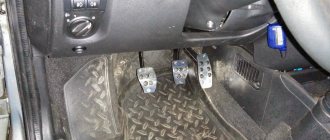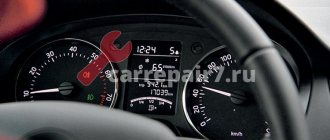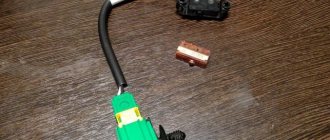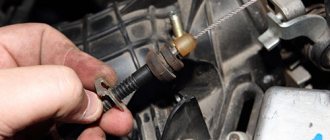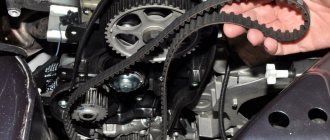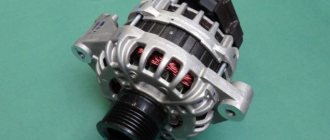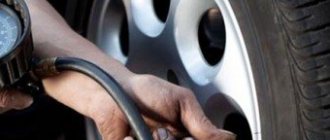I’ll say right away that this post is specifically about testing the above firmware, since at the moment the machine has stock firmware. Engine 8kl, 87 hp. Mileage - 47,000.
05/12/2016 - I decided to install firmware for Euro-2 from Paulus.
The issue price at RR Tuning is 2,500 rubles and a 2-week refund guarantee in case of a rollback to stock. The first sensations are that the car began to pick up a little faster from the bottom; at about 2,000 rpm the engine suddenly came to life. Fuel consumption is at stock level - up to 10-11 liters in the city, about 6 on the highway (with active driving). But the most important thing that I wanted to remove was the dullness of the e-throttle, which is checked at idle by the recoil speed after a sharp press on the gas:
This video was recorded on stock, as you can see the speed lags behind the reaction after sharply pressing the pedal. has changed in this regard
.
Another problem is when sometimes the engine grips very poorly after starting:
Also, nothing has changed; this happened twice over the weekend on the firmware.
In general, a feature of the firmware: a softer gas pedal - the car does not nod when driving in first gear. Mileage on firmware: about 300 kilometers.
05/16/2016 — the firmware was changed to Motor Master.
This firmware is no different from stock at all - it’s twitchy, and the consumption is generally wild - from 12 liters in the city. At idle it rarely drops below 1 liter/hour. On the plus side, it’s more dynamic than the Paulus on the highway when picking up speeds of 90-120 km/h. BUT: for a week and about 300-350 kilometers, there were never any problems with starting.
As a result: 05/23/2016 - the stock and the 2.5 thousand rubles spent were returned.
Which I don’t regret at all. Plus, I switched to 95 gasoline Lukoilovsky now, and there is no difference in the dynamics between stock and firmware, but rare problems with starting have returned.
Verdict:
Most likely, on VAZ engines it is logical to flash only 16kL prior engines. There is not very good traction from below, and firmware can solve this problem. 8kL engines with OSHPG are already high-torque at the bottom, and at the top, moving the cutoff will not give anything other than the crying and knocking of a bursting engine - the sound of these engines after 4-5 thousand revolutions is generally terrible.
Well, GPS measurements of dynamics 0-100 at 87 hp. engine on Paulus firmware:
A little less than 11.5 seconds, provided that the start is practically from idle, and the GPS and speedometer differ by about +5 km/h in favor of the speedometer. That is, according to the stopwatch and speedometer, you can keep plus/minus within 11 seconds. The results are approximately the same on both MM firmware and stock - in the range of 11.5-12 seconds according to GPS.
Thank you for your attention, I hope I helped you with choosing the firmware))
The Lada Granta, which first rolled off the assembly line in 2011, instantly became the sales leader in its class. An affordable price, an attractive set of options and a good selection of power plants – these are the advantages that domestic car enthusiasts appreciate. The option of choosing a transmission is very attractive - a five-speed manual transmission or a four-speed automatic from the Japanese company Jatco.
Fuel is supplied through a single-pipe line under the control of an electronic engine control system (ECM), which processes signals coming from sensors. Unlike previous models, the Itelma 11186 module is used here. According to owner reviews, it has somewhat unfinished software that can only be corrected by chip tuning Grants
at the software level.
Refinement of a new electronic gas pedal
There are two options for modifying the pedal:
On the lever of the removed pedal module, you can saw off a protrusion 2-3 mm thick, and then the amplitude of movement of the pedal will increase, acceleration can be carried out by hitting the lever “to the floor”.
The second option with which you can modify the part is to change the internal design. For this:
- Before removing the module, start the engine, place a ruler next to the part, and measure the position of the edge of the pedal.
- Smoothly lower the lever until you hear the growl of the motor.
- Record the idle distance of the part.
- Turn off the engine, tighten the handbrake, remove the negative from the battery.
- Remove the gas module.
- Using a Phillips screwdriver, remove the cover securing screws and the cover itself.
- Using the same screwdriver, remove the rheostat slider mount and set it aside.
- Remove the board - you will see springs underneath.
- Hold the spring with a screwdriver and remove it.
- Measure the distance between the support pad and the rubber in the body, while moving the pedal to the idle value.
- Place material under the platform with a thickness equal to the distance obtained in the previous step.
- Assemble the module and install it in place.
- Perform the check - start the engine. The idle speed should remain at the same level. If this is not the case, disassemble the module and remove several layers of padding.
Causes of the phenomenon
Drop in speed and failure of the gas pedal
There are few reasons for the phenomenon of “failure” when pressing the gas pedal. It often appears after unsuccessful engine chip tuning and is accompanied by an increase in fuel consumption, but there are other problems directly with injection. So, let’s look at the main reasons for the “failure” effect:
- Injectors. The fuel distribution system directly affects engine performance.
Identifying and eliminating ECU errors
Condition of the candles. On the left the mixture is too rich, on the right it is too lean.
These are all the main reasons that can lead to gas pedal failure.
Dips during acceleration
Once the causes are considered, we can consider how to deal with the problem. So, let’s describe step by step what needs to be done when the gas pedal has dips during acceleration:
- The first step is to check the spark plugs. The appearance of carbon deposits or spark plugs that are too clean indicate that the mixture is not adjusted correctly. It is worth adjusting the correct amount of fuel mixture.
- Ignition wires can also cause the vehicle to malfunction.
- A clogged throttle can lead to failures during acceleration.
- The condition of the air filter affects the formation of the mixture, so it is worth changing it on time.
Air filter clogged
Dirty fuel filter
Dirty fuel filter
- ECU errors can also lead to accelerator failures.
- The last reason is clogged injectors. They need to carry out diagnostics, check functionality, and also clean and replace faulty elements.
Thus, the causes of failures during overclocking have been identified and can be eliminated.
Gas leaks at idle
At idle, there are fewer reasons for failures, but they will have to be eliminated, since the car simply will not start normally, or stall after starting the engine. So, let's look at the work plan step by step:
- Checking the spark plugs. If the element fails, it is necessary to replace it.
Attention! It is recommended to change all four spark plugs to ensure smooth engine operation. Before installation, you should adjust the gap using a feeler gauge, which should be 1 mm for 92 gasoline
Checking and adjusting the spark plug gap using a feeler gauge
- We change the fuel filter, it is located under the bottom of the tank, and also carry out diagnostics on the fuel pump. If malfunctions are identified, they should be eliminated.
Clogged filter in the gasoline pump
All these reasons can cause dips to appear at idle (more precisely, when switching from idle to driving mode).
Reference data
Basic data on the unit is collected in the following table.
| Engine 21129 | |
| Model and symbol | 21129, 1.6l 16-cl |
| engine's type | Petrol, four-cylinder, in-line |
| Working volume | 1.6 l (1596 cm3) |
| Cylinder diameter, mm | 82 |
| Piston stroke, mm | 75,6 |
| Compression ratio | 10,5 |
| Number of camshafts | 2 |
| Valves per cylinder | 4 |
| Timing drive type | Toothed belt |
| Timing type | DOHC |
| Power kW/hp | 78/106 (at 5800 rpm) |
| Maximum torque, Nm | 148 (at 4200 rpm) |
| Minimum engine speed | 840 |
| RPM cut-off | 6200 |
| Weight, kg | 109,2 |
| Ignition system | Contactless, Electronic, microprocessor controlled |
| Cylinder operating order | 1-3-4-2 |
| Supply system | Multiport fuel injection |
| Fuel | Unleaded AI-95 |
| Neutralizer | Yes |
| Toxicity standards | Euro – 5 |
| Minimum pressure in the engine lubrication system at an oil temperature of 85 degrees and 5400 rpm, kPa | 441.3 - 637.4 (4.5-6.5 kgf/cm2) |
| Minimum pressure in the engine lubrication system at idle speed, kPa (kgf/cm2) | 196,2 (2,0) |
| Oil consumption depending on fuel consumed, % | 0,3 |
| Oil volume in the engine lubrication system with a steel sump, l | 2,9 |
| Oil volume in the engine lubrication system with a light-alloy sump, l | 4,1 |
| Engine oil quality class according to API | SL, SM or SN |
| Recommended motor oil viscosity grade according to SAE | 0W-30 (-40C/+25C) 0W-40 (-40C/+30C) 5W-30 (-30C/+25C) 5W-40 (-30C/+35C) 10W-30 (-25C/+25C) 10W-40 (-25C/+35C) 15W-40 (-20C/+45C) 20W-40 (-15C/+45C) 20W-50 (-15C/>45C) |
The cylinder block (BC) is cast and cast iron. Cooling cavities are formed directly during casting, but the feed channels are made by drilling. At the bottom of the BC there are 5 supports of the main bearings of the CV (crankshaft), while the caps of these bearings have a serial number, starting from the CV pulley and are not interchangeable with each other.
The holes for the oil intake bolts are located in the cover of the second main bearing. The material used for making the liners is steel-aluminum alloy.
The connecting rod and piston group (CPG) is the same as on the 21127 engine, lightweight with graphite coating on the piston skirts. Although they have special grooves at the bottom for the valves, they are not large enough to prevent their contact if the timing belt breaks. At the same time, at MMAC-2018, AVTOVAZ announced that in cars of the 2022 model series this long-standing problem will be solved and this will eliminate costly repairs due to untimely maintenance of the gas distribution mechanism.
As before, there are 3 rings per piston. Two of them are compression and one is oil scraper with a spring expander. But there is still one difference - the rings have become thinner, which makes it possible to reduce friction, which means increasing engine efficiency (reducing consumption, increasing power).
Fingers fixed with two locking rings, floating type.
The connecting rods are “chopped”, in the upper head of which a bushing made of steel-bronze alloy is pressed. The covers are installed in one position only and are not interchangeable.
The oil pump is driven by a drive from the front end of the crankshaft. There are also no changes in the operation of the oil pump - it takes oil from the oil pan using an oil receiver and supplies it under pressure to the engine lubrication channels. The level in the pan is controlled using a specially installed dipstick. A mandatory element is installed in the lubrication system - a filter with a check valve and a paper filter element. Thanks to the check valve, oil does not leak out of the channels back into the sump after stopping the engine.
In the new modifications of 21129, engineers added nozzles for oil cooling of the internal surfaces of the pistons. This should increase their resource. There are also special channels in the crankshaft body, thanks to which the connecting rod journals do not experience oil starvation.
All technological holes in the channels are closed using stamped steel plugs.
The car pulls to the side
It is clear that not only the brakes can be to blame for a car drifting off course - the wheel alignment angles, the wheels themselves, and the steering can also be to blame. However, quite often questions arise specifically about the brakes, especially if the car pulls sideways when braking. Most often, jammed pistons in the cylinders of one of the circuits are to blame. It is possible that the wheel may brake due to the loosening of the bolts securing the pad guide to the steering knuckle, as well as the pads getting oily or getting brake fluid on them.
Perhaps an ice or salt crust has formed on the surface of the pads, or the pads are simply wet. Or one of the circuits of the brake system does not work - the pedal is low and the braking efficiency is low. Brake disc runout, wheel bearing wear, and brake drum out-of-roundness may also be to blame.
How to fix overclocking failures
- Check the ignition wires and coils. When a breakdown occurs, the spark plug wires spark and glow in the dark. The engine shakes and jerks. This happens due to age, poor quality parts or poor contact with the spark plugs. The malfunction may be related to the engine temperature. The interwinding resistance of the coils and the thermal operating conditions change together, which is why a gasoline-powered car jerks during acceleration. If you have a diesel engine, jerks during acceleration are definitely not related to the operation of the coils; they are not there.
- Inspect the spark plugs. Poor contact with the wires, heavy carbon deposits, too lean or rich fuel mixture disable them. Unscrew and check each spark plug as in our article “Diagnostics of internal combustion engine operation using spark plugs,” where we gave examples of faulty spark plugs.
- Check the fuel, oil and air filters. Over time, they become clogged, which leads to deterioration in dynamics, increased fuel consumption and periodic failures. You can replace them yourself; they are inexpensive and easy to install.
If the tips above did not help, only diagnostics will solve the reason for this behavior of the gas pedal. Incorrect operation of systems, errors, composition of the fuel mixture - the diagnostician will name a specific malfunction.
Even if the engine is working properly, the car may move jerkily when accelerating. Motors that meet environmental standards Euro-4 and higher have this unpleasant property. The point is the reaction of the electronic throttle to pressing the gas pedal. It is nonlinear for the first 3–4 centimeters of travel. Because of this, failure may occur during overclocking.
Chip tuning to Euro-2 or Euro-0 standards improves the response of the gas pedal and solves the problem. ECU firmware has a number of other advantages:
- Improves overall dynamics, idle performance and traction at low speeds;
- The car does not stall when the air conditioning is on;
- Gear shifts smoother;
- Fuel consumption is reduced while maintaining driving style.
Video from our partner on how chip tuning copes with failures and “brooding” of the accelerator pedal on Gazelle Next:
Contact ADACT partners in your city for chip tuning. We guarantee a 10-day test drive, money back and replacement if you don't like the firmware.
Where to do chip tuning
We recommend watching
«>
Symptoms of a problem
Among the main signs of problems are:
- Absence of any reaction to the accelerator after starting the vehicle’s internal combustion engine;
- Dips, loss of throttle response while driving;
- Floating idle speed;
- Sharp jumps in speed when you gently press the accelerator;
- Idle speed too high.
The device contains movable electrical contacts, as well as conductive tracks - these elements are subject to wear during operation. In the operation of the engine, you can observe dips when picking up speed, unstable idling.
Related article: 5 of the best car speakers for high-quality sound
If there is a malfunction in the unit, the driver can see this by a warning light on the dashboard. In such a situation, the ECU will switch the engine to standby mode.
In this mode, you can observe a slow increase in speed, even if you press the accelerator sharply. In addition, the vehicle's fuel consumption may increase significantly.
If two sensors in a unit fail at once, the ECU will switch the operation of the internal combustion engine to emergency mode - the driver will not be able to influence the operation of the engine, the speed under any conditions will be slightly higher than the idle speed.
Removing and installing the gas pedal
It is necessary to immediately issue a warning: the part module is sealed. If you remove the seal and make amendments to the design yourself, the official dealer will notice this when you contact him during the warranty period and will refuse repairs under warranty, regardless of the reason for which you contact him.
To remove the pedal module, turn off the engine, remove the negative terminal from the battery and apply the handbrake. Do the following:
- Go down to the module with a flashlight and a 10mm socket (or socket) wrench.
- On the right, just above the accelerator pedal module bracket, you will find a wiring harness. Disconnect it.
- Remove the pedal module assembly.
- Reassemble in reverse order.
Upgrading the exhaust system
To further strengthen the engine of the sports car, it is recommended to supplement the tuning by making changes to the exhaust system. Namely, dismantle the existing exhaust manifold and install a “spider”. It will collect exhaust gases from several cylinders at once into one conducting pipe.
When purchasing such a collector, experts advise contacting manufacturers who have proven themselves well. Their products use high quality steel, which is treated to prevent rusting, and the wiring diagrams are calculated as successfully as possible.
Electronic gas pedal (accelerator) VAZ 1117-1119 electric drive, E-GAS new model
Dear customers, in order to avoid mistakes when sending an electronic gas pedal to the Lada Kalina, in the “Comment” line indicate your car model, year of manufacture, E-GAS or not.
The cars are equipped with an electronic throttle, the so-called E-throttle, designed to improve smoothness and eliminate jerking when pressing the gas. This is also dictated by the introduction of Euro 4 and 5 toxicity standards in Russia.
With an electronic gas pedal, the throttle valve is moved by an electric motor. This eliminates the need for a traditional mechanical connection between the accelerator pedal and the throttle valve. This means that the driver's intention from the accelerator pedal is transmitted to the control unit. Then the throttle valve moves. Thanks to this, the control unit can influence the amount of engine torque by moving the throttle valve, even when the driver does not change the position of the accelerator pedal. This makes it possible to achieve better coordination between engine systems.
In defining and comparing a regular mechanical and a special electronic gas pedal, a very simple real-life example can be given: a mechanical pedal is a classical guitar, and an electronic pedal is an electric guitar.
The electronic gas pedal 11183 on the Lada Kalina can be configured so that it becomes more responsive and a little livelier.
- Nut M6 with serrated shoulder 00001-0038321-01; 2. Electronic accelerator pedal of the old model 11183-1108500-00; 2. New electronic accelerator pedal 11183-1108500-01; 3. Bracket 11183-1108510-00
The manufacturer installs at least two types of electronic gas pedals on Lada Kalina cars (depending on the year of manufacture):
Old model (catalog number: 11183-1108500);
New sample (article: 11183-1108500-01).
You can determine the model of the accelerator pedal by the catalog number, which is glued to the side of the body. If you cannot access the sticker, you will have to remove the electronic gas pedal:
– Disconnect the block with wires next to the gas pedal;
– Unscrew three nuts using a “10” wrench;
– Remove the housing and pedal assembly.
Each block of the electronic gas pedal 11183 on the Lada Kalina is modified differently.
You do all further actions at your own peril and risk. In addition, you may lose your warranty.
ADJUSTMENT E-GAS 11183-1108500 OLD STYLE
The block cover (11183-1108500) is fixed with bolts that are inserted into oval holes. The modification is to loosen 4 screws and turn the cover in the desired direction:
Economy mode (counterclockwise). To drive smoothly, to accelerate, you should press the pedal a little more than before. Gasoline consumption is reduced;
Active mode (clockwise). The car reacts even with slight pressure on the gas pedal. Gasoline consumption increases. The pedal becomes more sensitive and informative.
In other words, we get the same effect as after installing JETTER (Jetter or spur).
It has been noticed that the first minutes after such settings, the idle speed may be increased (about 1300 rpm). But after a minute, the ECU gradually adjusted and the speed dropped to the usual level. If this does not happen, turn on the ignition for a minute and then start the engine.
If necessary, you can easily return to the original position (mark it in advance).
DEVELOPMENT OF NEW SAMPLE ELECTRONIC GAS PEDAL 11183-1108500-01
The pedal assembly (11183-1108500-01) does not have oval holes, which does not allow adjustment in the manner described above. Instead, it is proposed to cut off the protrusion (by 2-3 mm), which prevents the pedal from moving completely.
This modernization made it possible to increase the pedal travel, which made acceleration with “pedal to the floor” more active. It is also noted that there is no hesitation when pressing the pedal sharply.
Car enthusiasts who have already completed the adjustment note that if you move the pedal assembly cover clockwise, the car becomes a little more lively. If you press the pedal as before and the car starts to move, you have to get used to it and not press the gas so hard. When you press the pedal to the floor, you can't feel the difference.
Those who adjusted the E-gas for a quieter ride noticed that driving on the highway became more comfortable. Now, to maintain speed, you need to press the gas pedal a little harder, which allows your leg to not be as tense as before.
Why did AvtoVAZ need E-gas?
As I already said, environmental standards are becoming stricter every year, in order for the exhaust to comply with the standards, the cable had to be removed. This made it possible to get rid of the driver’s empty gasping, as well as other unnecessary actions that increase the toxicity of exhaust gases. The electronic pedal, as it were, regulates “at its own discretion” how to open the throttle. Even a sharp press on the pedal will be processed in such a way that as little harmful CO2 as possible is released into the atmosphere.
How it works?
An electronic pedal consists of three main elements: pedal, electric pedal. damper, as well as a sensor located on the pedal itself. The sensor reads the degree of pressure on the pedal, and then sends the data to the electronic unit. It receives the data, analyzes it and sends a signal to the electronic damper, which opens to the required degree.
What advantages does E-gas have for the motorist?
- First of all, the electronic pedal helps reduce fuel consumption.
- Despite the widespread belief that E-gas “presses” the engine, statistics show that electronics, on the contrary, improve dynamics. Although there is indeed a slight “stupidity” at the beginning.
Now about the disadvantages of E-gas
- Most often email. The pedal is criticized for its pause (“stupid”) at the start, when you press the pedal sharply and try to accelerate. According to many, the engine interacts poorly with the pedal, as a result of which approximately one second is lost. Although we have learned to correct this shortcoming.
- E-gas does not allow serious engine tuning, since the pedal negates all efforts. Installing a cable drive solves the problem. I would also like to note that we learned how to customize and customize the pedal for specific needs.
- The electronic pedal causes a lot of trouble during operation.
The main problems of E-gas
In addition to shortcomings with dynamics, other problems are also observed, for example, floating speed, “sticking” pedals, unauthorized throttle application. Main errors of the electronic pedal: (P2122-P2123, P2127-P2128, P2138).
In the office AvtoVAZ reports that when replacing the controller or removing the battery terminal, the electronic pedal requires adaptation.
To adapt E-gas, you must do the following:
- Connect the battery terminal if it was removed;
- Then turn the key in the ignition switch to the “ignition” position. You will see indicator lights on the dashboard. Wait half a minute and start the engine. The air temperature must be at least +7°C;
- After this, we adapt the ignition diagnostic function. We accelerate at second speed, after which we brake the engine from 4000 rpm to 1000 rpm. We perform six such cycles in one run.
Useful video: How to adjust the electronic pedal
Our service center is often visited by GAZelle cars, because this is a commercial vehicle that plows like a workhorse day and night. Every day, many GAZelles hit the roads of our country and sooner or later certain breakdowns arise, which we try to eliminate! Today is no exception. A GAZelle Business with a UMZ engine came to our repair zone! Well, let's help business!
After listening to the client: the car does not pull, the check light is on. After you turn the ignition off and on again, the car sometimes starts to work as it should, but then the problem repeats. The rpms don't rise above 2000.
Here it is, a workhorse!
Fig.1
Where to start repairs? Of course, with computer diagnostics. We connect the diagnostic equipment and read the errors that are registered in the engine control unit.
Fig.2
We are interested in the current error P2138 Throttle/Pedal Position Sensor/Switch “D”/”E” Voltage Correlation. What does it mean? This error literally stands for: P2138 incorrect voltage ratio “D”/”E” of the throttle position sensor or accelerator pedal. Our throttle valve is electronic, as is the gas pedal. That is, both the damper itself and the pedal may be faulty. In order to defect a pedal or throttle valve, you need to understand how they are designed, so first let’s look at their design features, structure and figure out what is the difference between a mechanical throttle valve and an electronic one.
The operating principle of the system with an electronic throttle valve and an electronic gas pedal.
Cylinder head
The cylinder head (cylinder head) is aluminum. The gasket between the two blocks is two-layer, metal. Inside the head there are 2 camshafts and 16 valves (2 for the intake and 2 for the exhaust of each cylinder). Hydraulic compensators are used as pushers. Their use eliminates the mandatory procedure for periodically setting the thermal clearances of the cylinder head valves.
The camshafts for intake and exhaust are different and therefore not interchangeable.
Spark plugs are installed on top of the cylinder head in recesses specially made for them - spark plug wells.
The generator is driven by a poly V-belt from the crankshaft. An automatic tension roller is used to set the direction of the belt along the pulleys.
The timing belt is covered with plastic covers.
The receiver and inlet pipeline are made of plastic in the form of a single non-separable structure.
As for the exhaust system, a steel manifold is used here, which is combined with a catalytic converter. As in the case of the cylinder head, a metal two-layer gasket is used for connection to the head of the manifold block.
Ultimately, the engine is covered on top with a stylish plastic cover.
If our story seemed short to you, then we suggest you watch the video about the 21129 motor below.
"Deep" tuning
True engine boost enthusiasts can go much further in their pursuits. Among the most popular measures:
- installation of forged pistons;
- cylinder boring;
- installation of a nitrogen accelerator;
- turbocharged engine.
If you intend to strengthen the engine of your Granta Sport in this way, it is better to carry out tuning in a comprehensive manner. Installing a forged group is pointless without intensifying the fuel supply, and turbocharging accelerates the wear of serial pistons. And do not forget that increased “sporty” engine power requires intervention in other car systems. It will be necessary to strengthen the brakes, modify the suspension, and make changes to the transmission. Without these procedures, you will not be able to enjoy the speed of your fret for long.
Design features of the Lada 21127 engine
ICE 21127 differs from its predecessor in the variable length of the intake pipe. The intake system has a resonance chamber shifted closer to the intake valve. To control air flow, engineers installed 4 electronic dampers. Now at high speeds the air flow follows a long path, at low speeds it goes through the chamber.
Thanks to the operation of the dampers, the efficiency of fuel combustion has increased: at the time of increasing power, fuel consumption has decreased. During the compression stroke, some air is expelled from the cylinder and then returned, increasing the pressure in front of the intake manifold. At low crankshaft speeds, the 21127 engine provides torque and good throttle response. At high levels, the unit develops high power.
In addition to the dampers, engineers equipped the ICE 21127 with DTV temperature and DBP pressure sensors instead of the mass air flow sensor DMRV. New sensors transmit air flow readings to an electronic system, which enriches or leans the fuel-air mixture depending on the operating mode of the engine. In practice, budget factory tuning saved drivers from the problem of floating idle speed.
VAZ did not make any other changes in the design of the 21127 engine:
- The cylinder block is made of cast iron with subsequent honing of the internal surface. When boring, it is necessary to maintain a gap between the piston and cylinder of 0.045 mm;
- spark plug well channels and channels for heat removal are cast in the aluminum head. A 0.45 mm metal gasket is installed between the block and the head;
- The gas distribution system is built according to the DOHC scheme with two camshafts for the intake and exhaust valves. The camshafts are driven by a 22mm wide Gates timing belt with a semi-circular tooth;
- to regulate the thermal gap between the camshaft cams and valves, hydraulic compensators are installed;
- The lightweight connecting rod and piston group is manufactured by Federal Mogul. The pistons are cooled through special nozzles pressed into the main bearing supports;
- Engine lubricant is supplied under pressure to the crankshaft bearings, camshafts and hydraulic compensators. Oil is splashed onto the cylinder walls, pistons, camshafts and valve stems;
- ignition system with individual coils for each spark plug;
- fuel is supplied in a phased manner through the injectors according to a signal from the ECU.
For engine tuning 21127, experts offer:
- increase power to 115 hp. With. by installing a 54 mm damper instead of 52 mm and a 51 mm exhaust pipe with the Spider 4-2-1 system;
- replace the camshafts with Stolnikov 8.9 or similar USA, ClubTurbo, etc. to obtain power at high speeds;
- to achieve 150 hp You will need to replace the shafts with Stolnikov 9.15 with phase 316, bore the head for 31 and 27 mm valves, install Bosch 360cc or 440cc injectors.
Principle of operation
The electronic gas pedal design involves transmitting a signal through built-in sensors to the control unit. This allows you to regulate the supply of air mixture to the engine compartments, which, accordingly, directly affects the speed of the vehicle.
How the electronic gas pedal works:
There are sensors on the accelerator pedal. They transmit information about the angle of pressure to the car's ECU. The control unit instantly analyzes the received data and makes a decision about the need to open the throttle valve to the required amount. The need to change this value is also accepted automatically
This is important when choosing a comfortable operating mode for the engine.
It is the possibility of automatic adjustment that often confuses experienced drivers. Driving a car is not 100% dependent on driving skills, which presents certain difficulties. With some practical experience, this drawback is quickly smoothed out, but at the beginning of “acquaintance” with the electronic pedal it represents a noticeable inconvenience.
Options
{loadposition adsense2}
The basic package called Optima (LADA engine 1.6 l, 106 hp, manual transmission) includes two front airbags, ESC stability control system (includes ABS and non-disabled traction control), hill start assist system, audio system, driver's seat height adjustment, ERA-GLONASS emergency warning system, front seat belts with pretensioners and load limiters, LED daytime running lights, central locking with remote control from a folding key, 16-inch alloy wheels, etc.
The list of equipment for the Top version is supplemented by fog lights, electric drive and heated exterior mirrors, parking sensors, and a multimedia system with navigator.
For the flagship XRAY, a Prestige package is offered, which includes a heated windshield, a rear view camera, climate control, rain and light sensors and enhanced window tinting.
More details about the most expensive Exclusive package here
Prices are valid for July 2022
Enlarge price list
Additional payment for metallic paint of the body - 12 thousand rubles.
More details about prices and configurations above in the prices section
All X-Rays come on 16-diameter alloy wheels with Pirelli tires.
Fuel tank capacity is 50 liters.
see how the top version of Xray differs from the basic one (photo)
Attention to the salon
The design inside the Granta is not bad, the seats are quite comfortable - there is lateral support and heating. However, if you want to own a non-standard version of the Sport Grant, tuning the interior is still necessary. At least in minimal quantities.
- In the case of the Lada Granta Sport, interior tuning most often begins with the installation of alternative dashboard lighting. The algorithm of actions is simple: the devices are dismantled, and the LEDs on the board are soldered to a variant of a different color.
- Next, you can finish the handles and mirrors to match the body. The most commonly used is spray paint.
- A good idea for the Lada Granta Sport: tuning the interior - in terms of the “chrome” frame of the deflectors, as well as the console.
- You can cover the elements inside the cabin with vinyl.
- We supplement the heating of the mirrors by integrating an electric drive into them.
Related link:
Recommendations from experts for replacing the generator on the Lada Grant
Try to implement these ideas for tuning sport grants 2022 - the only thing that can limit the flight of its owner’s imagination is a lack of money or lack of time.
Repair
If there are any problems with the pedal, then only a complete replacement of the unit will help. But before changing anything, it is worth identifying the cause of the malfunction. To do this, you can use a multimeter test.
You can disconnect the sensors and the block and remove the pedal. Check the resistance - when you press the gas it should change slowly. Jumps in indicators indicate malfunctions.
But sometimes repairs are possible - for example, the wiring is damaged. If a wiring defect is detected, you can use the following diagram.
- Release the axis on which the gear is attached.
- Remove the wiring harness.
- Then the wires are soldered off.
- Release the bracket and pull out the cable.
Next, change the wires and solder them according to the connector under the pedal.
Source
How to check E-gas
If you have doubts about the performance of the product itself, you should dismantle and check the unit using a multimeter.
Main symptoms of a malfunction:
- “Chek” lighted up on the dashboard (error 0504 during diagnostics);
- when you press the gas pedal, the responsiveness disappeared;
- increased engine speed is diagnosed when changing gearbox speeds.
If we talk about the causes of malfunctions, the most common of them are:
- failure of one or both MPG sensors;
- malfunction of sensors as a result of oxidation of contact tracks, their contamination.
As mentioned earlier, in order to check E-gas grants, you need to use a multimeter. To carry out diagnostic measurements of electrical circuits, the module must be dismantled by first disconnecting it from the contact chip.
After that, you need to switch the operating position of the measuring device to ohmmeter mode. The point of the test is that it is necessary to alternately measure the condition of the contacts and conductive paths of the MPG sensors. For example: connect one probe of the device to contact No. 2, and the other to No. 4. While keeping both probes attached, slowly step on the gas pedal and observe the readings on the meter. A normal reaction is considered to be a smooth decrease in electrical resistance when pressing the accelerator. An abrupt, unstable decrease indicates a possible sensor malfunction. A similar sequence of actions is taken for the remaining contacts.
Engines
{loadposition direct5}
Attention! Xray with a 1.6 liter 110 horsepower Nissan engine will be discontinued in June 2022. Lada Xray received a 1.6-liter Nissan engine labeled H4 with a power of 110 hp
(156 Nm), it is now installed on the Nissan Sentra, although it produces 114 hp. The second engine is also a 1.6-liter, 106-horsepower (148 Nm), VAZ, with index 21129 and known from other Lada models
Lada Xray received a 1.6-liter Nissan engine labeled H4 with a power of 110 hp. (156 Nm), it is now installed on the Nissan Sentra, although it produces 114 hp. The second engine is also a 1.6-liter, 106-horsepower (148 Nm), VAZ, with index 21129 and known from other Lada models.
In addition, the hatchback also received a 1.8-liter engine (index 21179), developed at AVTOVAZ. The power of the new engine will be 122 hp. and 170 Nm of torque. This will be the top engine for the Xray and only the VAZ “robot” will be available with it. Updated! In the fall, with 1.8, a manual transmission also appeared (see test drive Lada X Ray 1.8 + manual transmission).
Acceleration to 100 km/h and fuel consumption: 1.6 l engine, 106 hp. (mechanics) - 11.9 seconds, consumption per 100 km. — 7.5 liters 1.6 liters engine, 110 hp. (mechanics) - 10.3 seconds, consumption per 100 km. - 6.9 liters - 1.8 liter engine, 122 hp, discontinued. (robot) - 10.9 seconds, consumption per 100 km. — 7.1 liters
More details in the section: technical specifications
Expert answer
The following two tabs change content below.
About the expert:
Lada expert An expert on Lada cars with many years of experience. I own a Lada Granta car, I collect cramps based on the Priora. Sometimes I stay overnight in the garage. My wife is more jealous of cars than of women.
I can assume that due to power surges, the engine control system “glitched” and went into emergency mode. It’s a pity that we didn’t look at the error code, but most likely the error was: “Low signal level of the gas pedal sensor.”
In this case, you did everything right. We found a box in which it does not rain and removed the battery.
>
Removing a battery terminal in heavy rain is dangerous; the battery may short out and explode! Yes, this is not a joke, batteries explode!
If you have a similar situation when the engine does not respond to the gas pedal and an error appears on the instrument panel screen, then try the following:
- turn on the ignition and sharply press the gas pedal all the way several times.
Press the gas pedal all the way down - Start the car, if it idles steadily, then again sharply press the gas pedal all the way.
- Next to the pedal there is a so-called “frog” - this is the contact block with the wires. Move it, take it off and put it on again (just before doing this, remove the terminal from the battery).
- The brake pedal frog could also be stuck. This is easy to check; if this happens, the rear brake lights should be on. The brake pedal may also squeak when driving. This is what the brake pedal frog looks like
Detailed video about removing the frog pedal
If all else fails, then you need to contact the dealer or an experienced diagnostician. Most likely, your ECU (electronic control unit of the car) has been flooded with water, or a short hole has appeared in the area from the pedal assembly to the rear dimensions. Or the electronic gas pedal could even break down.
More about that!
One of the symptoms of a faulty frog (pedal limit switch) is failures during acceleration, but failures can also be caused by a clogged fuel filter.
>
In connection with the introduction of European exhaust emission standards, at the beginning of 2011, the AvtoVAZ concern began equipping Lada cars with the E-gas system. Subsequently, the manufacturer provided Grant with an electronic gas pedal.
The general meaning of the operation of the electronic system is that by moving the gas selector pedal, special sensors are activated, which are located in the gas pedal module (hereinafter referred to as MPG). With each change in the force exerted on the MG, the resistance of the sensors also changes. After which an electrical signal is generated, which enters the ECU, is read, processed, and depending on the degree of pressing and the results of processing, the final operation of the throttle valve is regulated.
The design and principle of operation of the electronic gas pedal
To understand how it works and functions, you need to roughly understand the general circuit of the mechanical analogue. The functions of these systems are similar, but the simplest unit can only be considered a traditional drive.
The gas pedal is a control element for the throttle and its damper. The function of the throttle is to regulate the amount of air. The more air, the higher the engine speed the crankshaft will rotate. The pedal is connected to the throttle drive via a cable drive or levers. All this significantly reduces the effort required to press the gas.
The operating principle of the electronic unit is more complex, but this makes the process of controlling speed easier. The electronic accelerator is used only on engines with an injection power system. Its device is completely electronic. It is based on electronic modules that convert electrical signals.
Advice
Today, all manufacturers are moving to electronic pedals in one way or another, and you shouldn’t refuse to buy a specific car just because its gas is not controlled by a cable. Just keep in mind that electronic throttle control will delay engine response. You must always keep this delay in mind and press or release the gas a little earlier than required (it is clear that this is not always possible). Only the car manufacturer can influence the delay time by changing the algorithms for operating the gas pedal, or by installing faster hardware in the engine control unit.
WE RECOMMEND ALSO READ:
Phone chip tuning in Tolyatti 89631161168
What is chip tuning? Updates in software for a car engine! Any electronic control unit M74 engine ECU contains a program for its operation. A set of correction characteristics for various engine operating modes is stored in the computer's memory. The control unit, receiving signals from various sensors, controls the operation of actuators to ensure optimal (according to the developers) engine operation. The necessary parameters for controlling actuators are calculated in accordance with incoming data and a set of correction coefficients stored in the computer's memory. Thus, wanting to change the operation of the engine without altering its mechanical components, we have two obvious ways for this: The first is changing the incoming signals (for example, changing the stiffness of the air flow meter damper return spring). The second is the change by the ECU firmware of the correction factors in the memory of the stoichiometric characteristics of the engines components in the software sum and thus we do chip tuning of the engine. All the firmware that we have in Togliatti is made by branded specialists!
Description of the problem
In general, there was a terrible downpour, puddles on the roads, and general floods in the yards.
Heavy rain could affect the operation of the car's electronic systems
But we had to go, my wife and daughter were in the shopping center, and the queue for the minibus, according to them, was huge. I am inclined to believe that the minibuses simply stalled (we have old, decrepit Gazelles in our city).
Criticism of the model
Why the clutch slips, diagnostics and main faults. Among the assessments of acceleration programs, there are also negative ones. Critics argue that the attractiveness of developing their own startups to the tech intelligentsia creates a tight labor market for tech companies. It is noted that while focusing on training founders, accelerators produce few
viable, investment-attractive projects. In the growing number of accelerator graduates, some critics see the potential for an overvalued
companies, which could lead to a loss of confidence in the industry and a drop in the valuation of technology startups as such.
product pic1 res
A two-mode “booster,” so to speak, deceives the ECU: it makes it think that we pressed the pedal harder than it actually happened. It works in a more rigid coupling with the engine
But it is important to understand that this will not result in more “horses” and the nominal acceleration will not change, it’s just that the ecological “cotton wool” disappears from the pedal. In principle, the driver could drive at the same pace before, just press with his right foot more boldly
Next up is a Mini at the go-kart track and a Tiguan in the city. Both cars only confirm the above. However, sitting in a Volkswagen crossover, I very opportunely remember about the sport mode of the DSG transmission and decide to compare it with the operation of a “booster”. The latter predictably pales in comparison to this convenient feature. I think that for cars that have a “sport mode”, the accelerator will most likely be superfluous. The “brain” block of modern two-pedal boxes makes the actuators move faster in “sport”; pushes down a gear quickly and coordinates it with engine speed, achieving the best torque output. This is the real environmental killer. But the “booster” does not have such an arsenal.
Diagnostics
Most often, drivers complain about the following problems with electronic gas:
- The speed fluctuates (standby mode);
- The engine does not respond to gas (emergency operation);
- Pedal play.
If in the latter case the malfunction may be purely mechanical, then in the first two there is clearly a problem with the electronics. In this case, the initial diagnosis of the electronic gas pedal can be carried out independently, but for this it must first be dismantled:
- Disconnect the block with wires;
- Using a “10” wrench, unscrew the three nuts securing the pedal;
- Remove the pedal.
To check the condition of the moving contacts and conductive paths of the gas pedal position sensors:
- Using a multimeter in ohmmeter mode, check the resistance between contacts “4” and “2”. Slowly move the gas pedal, at this time the resistance should change smoothly.
- We also check the resistance between contacts “4” and “3”.
- To check the conductive paths of another sensor, we measure the resistance between two other pairs of contacts: “1” and “6”, as well as “6” and “5”.
If there is an abrupt change in resistance on any of the pair of contacts described above, we can say with confidence that the E-gas pedal is faulty. It will need to be replaced as a whole with a new one.

